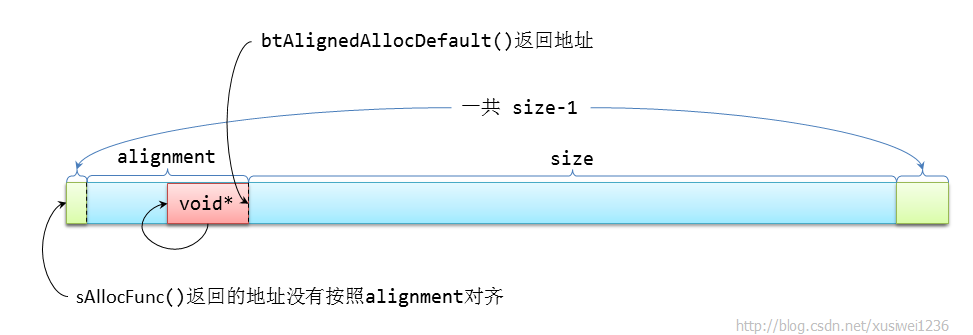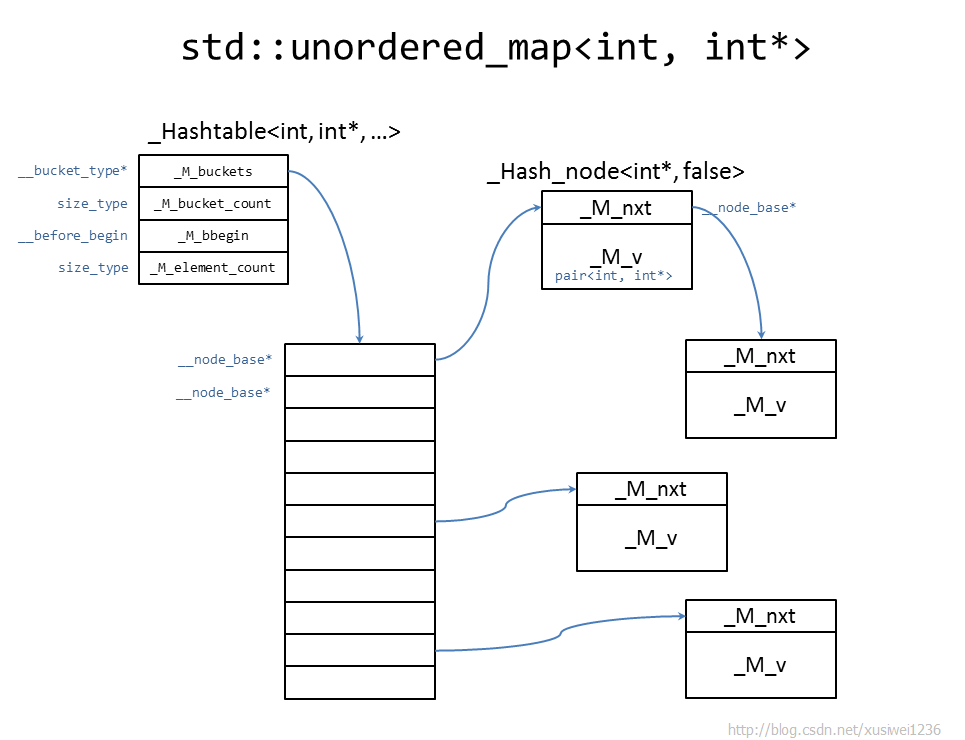last modified time:2014-11-9 14:07:00
bullet 是一款开源物理引擎,它提供了碰撞检測、重力模拟等功能,非常多3D游戏、3D设计软件(如3D Mark)使用它作为物理引擎。
作为物理引擎,对性能的要求是非常苛刻的;bullet项目之所以可以发展到今天,非常大程度取决于它在性能上优异的表现。
翻阅bullet的源代码就能看到非常多源代码级别的优化。本文将介绍的HashMap就是一个典例。
bullet项目首页:http://bulletphysics.org/
注:bullet非常多函数定义了Debug版和Release版两个版本号。本文仅以Release版为例。
btAlignedAllocator的接口定义
///The btAlignedAllocator is a portable class for aligned memory allocations.
///Default implementations for unaligned and aligned allocations can be overridden by a custom allocator
// using btAlignedAllocSetCustom and btAlignedAllocSetCustomAligned.
template < typename T , unsigned Alignment >
class btAlignedAllocator {typedef btAlignedAllocator< T , Alignment > self_type;public://just going down a list:btAlignedAllocator() {}/*btAlignedAllocator( const self_type & ) {}*/template < typename Other >btAlignedAllocator( const btAlignedAllocator< Other , Alignment > & ) {}typedef const T* const_pointer;typedef const T& const_reference;typedef T* pointer;typedef T& reference;typedef T value_type;pointer address ( reference ref ) const { return &ref; }const_pointer address ( const_reference ref ) const { return &ref; }pointer allocate ( size_type n , const_pointer * hint = 0 ) {(void)hint;return reinterpret_cast< pointer >(btAlignedAlloc( sizeof(value_type) * n , Alignment ));}void construct ( pointer ptr , const value_type & value ) { new (ptr) value_type( value ); }void deallocate( pointer ptr ) {btAlignedFree( reinterpret_cast< void * >( ptr ) );}void destroy ( pointer ptr ) { ptr->~value_type(); }template < typename O > struct rebind {typedef btAlignedAllocator< O , Alignment > other;};template < typename O >self_type & operator=( const btAlignedAllocator< O , Alignment > & ) { return *this; }friend bool operator==( const self_type & , const self_type & ) { return true; }
}; void* btAlignedAllocInternal (size_t size, int alignment);void btAlignedFreeInternal (void* ptr);#define btAlignedAlloc(size,alignment) btAlignedAllocInternal(size,alignment)#define btAlignedFree(ptr) btAlignedFreeInternal(ptr)static btAlignedAllocFunc *sAlignedAllocFunc = btAlignedAllocDefault;
static btAlignedFreeFunc *sAlignedFreeFunc = btAlignedFreeDefault;void btAlignedAllocSetCustomAligned(btAlignedAllocFunc *allocFunc, btAlignedFreeFunc *freeFunc)
{sAlignedAllocFunc = allocFunc ? allocFunc : btAlignedAllocDefault;sAlignedFreeFunc = freeFunc ?freeFunc : btAlignedFreeDefault; } void* btAlignedAllocInternal (size_t size, int alignment) { gNumAlignedAllocs++; // 和gNumAlignedFree结合用来检查内存泄露 void* ptr; ptr = sAlignedAllocFunc(size, alignment); // printf("btAlignedAllocInternal %d, %x\n",size,ptr); return ptr; } void btAlignedFreeInternal (void* ptr) { if (!ptr) { return; } gNumAlignedFree++; // 和gNumAlignedAllocs 结合用来检查内存泄露 // printf("btAlignedFreeInternal %x\n",ptr); sAlignedFreeFunc(ptr); }
// The developer can let all Bullet memory allocations go through a custom memory allocator, using btAlignedAllocSetCustom
void btAlignedAllocSetCustom(btAllocFunc *allocFunc, btFreeFunc *freeFunc);// If the developer has already an custom aligned allocator, then btAlignedAllocSetCustomAligned can be used.
// The default aligned allocator pre-allocates extra memory using the non-aligned allocator, and instruments it.
void btAlignedAllocSetCustomAligned(btAlignedAllocFunc *allocFunc, btAlignedFreeFunc *freeFunc);
不管是否定制自己的Alloc/Free(或AllignedAlloc/AlignedFree),bullet内的其它数据结构都使用btAlignedAllocator作为内存分配(回收)的接口。随后将会看到。btAlignedAllocator的定制化设计与std::allocator的不同。文末具体讨论。
btAlignedAllocator的内存对齐
btAlignedAllocator除了定制化与std::allocator不同外,还添加了内存对齐功能(从它的名字也能看得出来)。
继续查看btAlignedAllocDefault/btAlignedFreeDefault的定义(btAlignedAllocator.{h|cpp})能够看到:
#if defined (BT_HAS_ALIGNED_ALLOCATOR)
#include <malloc.h>
static void *btAlignedAllocDefault(size_t size, int alignment)
{return _aligned_malloc(size, (size_t)alignment); // gcc 提供了
}static void btAlignedFreeDefault(void *ptr)
{_aligned_free(ptr);
}
#elif defined(__CELLOS_LV2__)
#include <stdlib.h>static inline void *btAlignedAllocDefault(size_t size, int alignment)
{return memalign(alignment, size);
}static inline void btAlignedFreeDefault(void *ptr)
{free(ptr);
}
#else // 当前编译环境没有 对齐的(aligned)内存分配函数
static inline void *btAlignedAllocDefault(size_t size, int alignment)
{void *ret;char *real;real = (char *)sAllocFunc(size + sizeof(void *) + (alignment-1)); // 1. 多分配一点内存if (real) {ret = btAlignPointer(real + sizeof(void *),alignment); // 2. 指针调整*((void **)(ret)-1) = (void *)(real); // 3. 登记实际地址} else {ret = (void *)(real);}return (ret);
}static inline void btAlignedFreeDefault(void *ptr)
{void* real;if (ptr) {real = *((void **)(ptr)-1); // 取出实际内存块 地址sFreeFunc(real);}
}
#endifbullet本身也实现了一个对齐的(aligned)内存分配函数。在系统没有对齐的内存分配函数的情况下,也能保证btAlignedAllocator::acllocate返回的地址是按特定字节对齐的。
以下就来分析btAlignedAllocDefault / btAlignedFreeDefault是怎样实现aligned allocation / free的。sAllocFunc/sFreeFunc的定义及初始化:
static void *btAllocDefault(size_t size)
{return malloc(size);
}static void btFreeDefault(void *ptr)
{free(ptr);
}static btAllocFunc *sAllocFunc = btAllocDefault;
static btFreeFunc *sFreeFunc = btFreeDefault;bullet同一时候提供了,AllocFunc/FreeFunc的定制化:
void btAlignedAllocSetCustom(btAllocFunc *allocFunc, btFreeFunc *freeFunc)
{sAllocFunc = allocFunc ? allocFunc : btAllocDefault;sFreeFunc = freeFunc ? freeFunc : btFreeDefault;
}
再来看看bullet是怎样实现指针对齐的(btScalar.h):
///align a pointer to the provided alignment, upwards
template <typename T>T* btAlignPointer(T* unalignedPtr, size_t alignment)
{struct btConvertPointerSizeT{union {T* ptr;size_t integer;};};btConvertPointerSizeT converter;const size_t bit_mask = ~(alignment - 1);converter.ptr = unalignedPtr;converter.integer += alignment-1;converter.integer &= bit_mask;return converter.ptr;
}接下来分析btAlignPointer是怎样调整指针的?
实际调用btAlignPointer时,使用的alignment都是2的指数。如btAlignedObjectArray使用的是16,以下就以16进行分析。
先如果unalignedPtr是alignment(16)的倍数,则converter.integer += alignment-1; 再 converter.integer &= bit_mask之后,unalignedPtr的值不变。还是alignment(16)的倍数。
再如果unalignedPtr不是alignment(16)的倍数,则converter.integer += alignment-1; 再converter.integer &= bit_mask之后。unalignedPtr的值将被上调到alignment(16)的倍数。
所以btAlignPointer可以将unalignedPtr对齐到alignment倍数。】
明确了btAlignPointer的作用。自然可以明确btAlignedAllocDefault中为什么多申请一点内存,申请的大小是size + sizeof(void *) + (alignment-1):
假设sAllocFunc返回的地址已经依照alignment对齐,则sizeof(void*)和sizeof(alignment-1)及btAlignedAllocDefault的返回值关系例如以下图所看到的:
void*前面的alignment-sizeof(void*)字节和尾部的sizeof(size)-1字节的内存会被浪费,只是非常小(相对内存条而言)管他呢。
假设sAllocFunc返回的地址没能按alignment对齐,则sizeof(void*)和sizeof(alignment-1)及btAlignedAllocDefault的返回值关系例如以下图所看到的:

PS: 顺便一提,为什么须要内存对齐?简单地说。依照机器字长倍数对齐的内存。CPU訪问的速度更快;详细来说,则要依据详细CPU和总线控制器的厂商文档来讨论的,那将涉及非常多平台、硬件细节,所以本文不正确该话题着墨太多。
btAlignedObjectArray——bullet的动态数组
btAlignedObjectArray的作用与STL的vector类似(下面称std::vector),都是动态数组。btAlignedObjectArray的数据成员(data member)声明例如以下:
template <typename T>
class btAlignedObjectArray
{btAlignedAllocator<T , 16> m_allocator; // 没有data member。不会添加内存int m_size;int m_capacity;T* m_data;//PCK: added this linebool m_ownsMemory;
// ... 省略
};btAlignedObjectArray同一时候封装了QuickSort。HeapSort。BinarySearch,LinearSearch函数,可用于排序、查找,btAlignedObjectArray的全部成员函数(member function)定义例如以下:
template <typename T>
//template <class T>
class btAlignedObjectArray
{btAlignedAllocator<T , 16> m_allocator;int m_size;int m_capacity;T* m_data;//PCK: added this linebool m_ownsMemory;#ifdef BT_ALLOW_ARRAY_COPY_OPERATOR
public:SIMD_FORCE_INLINE btAlignedObjectArray<T>& operator=(const btAlignedObjectArray<T> &other);
#else//BT_ALLOW_ARRAY_COPY_OPERATOR
private:SIMD_FORCE_INLINE btAlignedObjectArray<T>& operator=(const btAlignedObjectArray<T> &other);
#endif//BT_ALLOW_ARRAY_COPY_OPERATORprotected:SIMD_FORCE_INLINE int allocSize(int size);SIMD_FORCE_INLINE void copy(int start,int end, T* dest) const;SIMD_FORCE_INLINE void init();SIMD_FORCE_INLINE void destroy(int first,int last);SIMD_FORCE_INLINE void* allocate(int size);SIMD_FORCE_INLINE void deallocate();public: btAlignedObjectArray();~btAlignedObjectArray();///Generally it is best to avoid using the copy constructor of an btAlignedObjectArray,// and use a (const) reference to the array instead.btAlignedObjectArray(const btAlignedObjectArray& otherArray); /// return the number of elements in the arraySIMD_FORCE_INLINE int size() const;SIMD_FORCE_INLINE const T& at(int n) const;SIMD_FORCE_INLINE T& at(int n);SIMD_FORCE_INLINE const T& operator[](int n) const;SIMD_FORCE_INLINE T& operator[](int n);///clear the array, deallocated memory. Generally it is better to use array.resize(0), // to reduce performance overhead of run-time memory (de)allocations.SIMD_FORCE_INLINE void clear();SIMD_FORCE_INLINE void pop_back();///resize changes the number of elements in the array. If the new size is larger, // the new elements will be constructed using the optional second argument.///when the new number of elements is smaller, the destructor will be called,// but memory will not be freed, to reduce performance overhead of run-time memory (de)allocations.SIMD_FORCE_INLINE void resizeNoInitialize(int newsize);SIMD_FORCE_INLINE void resize(int newsize, const T& fillData=T());SIMD_FORCE_INLINE T& expandNonInitializing( );SIMD_FORCE_INLINE T& expand( const T& fillValue=T());SIMD_FORCE_INLINE void push_back(const T& _Val);/// return the pre-allocated (reserved) elements, this is at least // as large as the total number of elements,see size() and reserve()SIMD_FORCE_INLINE int capacity() const;SIMD_FORCE_INLINE void reserve(int _Count);class less{ public:bool operator() ( const T& a, const T& b ) { return ( a < b ); }};template <typename L>void quickSortInternal(const L& CompareFunc,int lo, int hi);template <typename L>void quickSort(const L& CompareFunc);///heap sort from http://www.csse.monash.edu.au/~lloyd/tildeAlgDS/Sort/Heap/template <typename L>void downHeap(T *pArr, int k, int n, const L& CompareFunc);void swap(int index0,int index1);template <typename L>void heapSort(const L& CompareFunc);///non-recursive binary search, assumes sorted arrayint findBinarySearch(const T& key) const;int findLinearSearch(const T& key) const;void remove(const T& key);//PCK: whole functionvoid initializeFromBuffer(void *buffer, int size, int capacity);void copyFromArray(const btAlignedObjectArray& otherArray);
};btAlignedObjectArray和std::vector类似。各成员函数的详细实现这里不再列出。
std::unordered_map的内存布局
btHashMap的内存布局与我们常见的HashMap的内存布局截然不同。为了和btHashMap的内存布局对照,这里先介绍一下std::unordered_map的内存布局。
GCC中std::unordered_map仅是对_Hahstable的简单包装。_Hashtable的数据成员定义例如以下:
__bucket_type* _M_buckets;size_type _M_bucket_count;__before_begin _M_bbegin;size_type _M_element_count;_RehashPolicy _M_rehash_policy;继续跟踪_bucket_type,能够看到(_Hashtable):
using __bucket_type = typename __hashtable_base::__bucket_type; using __node_base = __detail::_Hash_node_base;using __bucket_type = __node_base*;至此。才知道_M_buckets的类型为:_Hash_node_base**
继续追踪。能够看到_Hash_node_base的定义: /*** struct _Hash_node_base** Nodes, used to wrap elements stored in the hash table. A policy* template parameter of class template _Hashtable controls whether* nodes also store a hash code. In some cases (e.g. strings) this* may be a performance win.*/struct _Hash_node_base{_Hash_node_base* _M_nxt;_Hash_node_base() : _M_nxt() { }_Hash_node_base(_Hash_node_base* __next) : _M_nxt(__next) { }};从_Hashtable::_M_buckets(二维指针)和_Hash_node_base的_M_nxt的类型(指针)。能够推測Hashtable的内存布局——buckets数组存放hash值同样的node链表的头指针,每一个bucket上挂着一个链表。
继续看__before_begin的类型(_Hashtable):
using __before_begin = __detail::_Before_begin<_Node_allocator_type>; /*** This type is to combine a _Hash_node_base instance with an allocator* instance through inheritance to benefit from EBO when possible.*/template<typename _NodeAlloc>struct _Before_begin : public _NodeAlloc{_Hash_node_base _M_node;_Before_begin(const _Before_begin&) = default;_Before_begin(_Before_begin&&) = default;template<typename _Alloc>_Before_begin(_Alloc&& __a): _NodeAlloc(std::forward<_Alloc>(__a)){ }}; iteratorbegin() noexcept{ return iterator(_M_begin()); }__node_type*_M_begin() const{ return static_cast<__node_type*>(_M_before_begin()._M_nxt); }const __node_base&_M_before_begin() const{ return _M_bbegin._M_node; }
实际存放Value的node类型为以下两种的当中一种(按Hash_node_base的凝视,Key为string时可能会用第一种,以提升性能):
/*** Specialization for nodes with caches, struct _Hash_node.** Base class is __detail::_Hash_node_base.*/template<typename _Value>struct _Hash_node<_Value, true> : _Hash_node_base{_Value _M_v;std::size_t _M_hash_code;template<typename... _Args>_Hash_node(_Args&&... __args): _M_v(std::forward<_Args>(__args)...), _M_hash_code() { }_Hash_node*_M_next() const { return static_cast<_Hash_node*>(_M_nxt); }};/*** Specialization for nodes without caches, struct _Hash_node.** Base class is __detail::_Hash_node_base.*/template<typename _Value>struct _Hash_node<_Value, false> : _Hash_node_base{_Value _M_v;template<typename... _Args>_Hash_node(_Args&&... __args): _M_v(std::forward<_Args>(__args)...) { }_Hash_node*_M_next() const { return static_cast<_Hash_node*>(_M_nxt); }};_Hashtable::insert:
template<typename _Pair, typename = _IFconsp<_Pair>>__ireturn_typeinsert(_Pair&& __v){__hashtable& __h = this->_M_conjure_hashtable();return __h._M_emplace(__unique_keys(), std::forward<_Pair>(__v));}
_Hashtable::_M_emplace(返回值类型写得太复杂,已删除):
_M_emplace(std::true_type, _Args&&... __args){// First build the node to get access to the hash code__node_type* __node = _M_allocate_node(std::forward<_Args>(__args)...); // 申请链表节点 __args为 pair<Key, Value> 类型const key_type& __k = this->_M_extract()(__node->_M_v); // 从节点中抽取 key__hash_code __code; __try{__code = this->_M_hash_code(__k);}__catch(...){_M_deallocate_node(__node);__throw_exception_again;}size_type __bkt = _M_bucket_index(__k, __code); // 寻找buckets上的相应hash code相应的indexif (__node_type* __p = _M_find_node(__bkt, __k, __code)) // 在bucket所指链表上找到实际节点{// There is already an equivalent node, no insertion_M_deallocate_node(__node);return std::make_pair(iterator(__p), false);}// Insert the nodereturn std::make_pair(_M_insert_unique_node(__bkt, __code, __node),true);}_Hashtable::_M_find_node:
__node_type*_M_find_node(size_type __bkt, const key_type& __key,__hash_code __c) const{__node_base* __before_n = _M_find_before_node(__bkt, __key, __c);if (__before_n)return static_cast<__node_type*>(__before_n->_M_nxt);return nullptr;}_Hashtable::_M_find_before_node(返回值类型写得太复杂,已删除):
_M_find_before_node(size_type __n, const key_type& __k,__hash_code __code) const{__node_base* __prev_p = _M_buckets[__n]; // 取出头指针if (!__prev_p)return nullptr;__node_type* __p = static_cast<__node_type*>(__prev_p->_M_nxt);for (;; __p = __p->_M_next()) // 遍历链表{if (this->_M_equals(__k, __code, __p)) // key匹配?return __prev_p;if (!__p->_M_nxt || _M_bucket_index(__p->_M_next()) != __n)break;__prev_p = __p;}return nullptr;}看到_Hashtable::_M_find_before_node的代码,就验证了此前我们对于Hashtable内存布局的猜想:这和SGI hash_map的实现体hashtable的内存布局同样(详情可參考《STL源代码剖析》,侯捷先生著)。
(PS:追踪起来并不轻松,能够借助Eclipse等集成开发环境进行)
比如,std::unordered_map<int, int*>背后的Hashtable的一种可能的内存布局例如以下:
std::unordered_map的内存布局是大多数<数据结构>、<算法>类教材给出的“标准做法”,也是比較常见的实现方法。
btHashMap
btHashMap的内存布局。与“标准做法”截然不同。例如以下可见btHashMap的数据成员(data member)定义:
template <class Key, class Value>
class btHashMap
{protected:btAlignedObjectArray<int> m_hashTable;btAlignedObjectArray<int> m_next;btAlignedObjectArray<Value> m_valueArray;btAlignedObjectArray<Key> m_keyArray;
// ... 省略
};依据命名。能够推測:
m_keyArray和m_valueArray分别存放key和value;
m_next的作用应该是存放k/v array的index,以此形成链表。
m_hashTable的作用应该和前面_M_bukets所指向的数组类似,作为表头;
以下通过分析btHashMap的几个方法,来对这几个推測一一验证。
btHashMap::findIndex
以下来看看btHashMap::findIndex的实现:
int findIndex(const Key& key) const{unsigned int hash = key.getHash() & (m_valueArray.capacity()-1); // 依赖 Key::getHash()if (hash >= (unsigned int)m_hashTable.size()){return BT_HASH_NULL;}int index = m_hashTable[hash]; // index相当于unordered_map的buckets[hash]的链表头指针while ((index != BT_HASH_NULL) && key.equals(m_keyArray[index]) == false) // 遍历链表。直到匹配,依赖 Key::equals(Key){index = m_next[index]; }return index;}btHashMap::findIndex用到了m_hashTable。m_keyArray,m_next,能够看出:
m_hashTable的作用确实类似于unordered_map的buckets数组;
m_keyArray确实是存放了key;
m_next[i]确实类似于unordered_map链表节点的next指针。
btHashMap::insert
接下来看看btHashMap::insert:
void insert(const Key& key, const Value& value) {int hash = key.getHash() & (m_valueArray.capacity()-1);//replace value if the key is already thereint index = findIndex(key); // 找到了<Key, Value>节点if (index != BT_HASH_NULL){m_valueArray[index]=value; // 找到了,更行valuereturn;}int count = m_valueArray.size(); // 当前已填充数目int oldCapacity = m_valueArray.capacity();m_valueArray.push_back(value); // value压入m_valueArray的尾部,capacity可能增长m_keyArray.push_back(key); // key压入m_keyArray的尾部int newCapacity = m_valueArray.capacity();if (oldCapacity < newCapacity) {growTables(key); // 假设增长。调整其余两个数组的大小。并调整头指针所在位置//hash with new capacityhash = key.getHash() & (m_valueArray.capacity()-1);}m_next[count] = m_hashTable[hash]; // 连同下一行,将新节点插入 m_hashTable[hash]链表头部m_hashTable[hash] = count;}
这里验证了:m_valueArray存放的确实是value。
btHashMap::remove
btHashMap与普通Hash表的差别在于,它可能要自己管理节点内存;比方,中间节点remove掉之后。怎样保证下次insert可以复用节点内存?通过btHashMap::remove可以知道bullet是怎样实现的:
void remove(const Key& key) {int hash = key.getHash() & (m_valueArray.capacity()-1);int pairIndex = findIndex(key); // 找到<Key, Value>的 indexif (pairIndex ==BT_HASH_NULL){return;}// Remove the pair from the hash table.int index = m_hashTable[hash]; // 取出头指针btAssert(index != BT_HASH_NULL);int previous = BT_HASH_NULL;while (index != pairIndex) // 找index的前驱{previous = index;index = m_next[index];}if (previous != BT_HASH_NULL) // 将当前节点从链表上删除{btAssert(m_next[previous] == pairIndex);m_next[previous] = m_next[pairIndex]; // 当前节点位于链表中间}else {m_hashTable[hash] = m_next[pairIndex]; // 当前节点是链表第一个节点}// We now move the last pair into spot of the// pair being removed. We need to fix the hash// table indices to support the move.int lastPairIndex = m_valueArray.size() - 1; // If the removed pair is the last pair, we are done.if (lastPairIndex == pairIndex) // 假设<Key, Value>已经是array的最后一个元素。则pop_back将减小size(capacity不变){m_valueArray.pop_back();m_keyArray.pop_back();return;}// Remove the last pair from the hash table. 将最后一个<Key, Value>对从array上移除int lastHash = m_keyArray[lastPairIndex].getHash() & (m_valueArray.capacity()-1);index = m_hashTable[lastHash];btAssert(index != BT_HASH_NULL);previous = BT_HASH_NULL;while (index != lastPairIndex){previous = index;index = m_next[index];}if (previous != BT_HASH_NULL){btAssert(m_next[previous] == lastPairIndex);m_next[previous] = m_next[lastPairIndex];}else{m_hashTable[lastHash] = m_next[lastPairIndex];}// Copy the last pair into the remove pair's spot. 将最后一个<Key, Value>复制到移除pair的空当处m_valueArray[pairIndex] = m_valueArray[lastPairIndex];m_keyArray[pairIndex] = m_keyArray[lastPairIndex];// Insert the last pair into the hash table , 将移除节点插入到m_hashTable[lastHash]链表的头部m_next[pairIndex] = m_hashTable[lastHash];m_hashTable[lastHash] = pairIndex;m_valueArray.pop_back();m_keyArray.pop_back();}内存紧密(连续)的优点
btHashMap的这样的设计。可以保证整个Hash表内存的紧密(连续)性。而这样的连续性的优点主要在于:
第一,能与数组(指针)式API兼容。比方非常多OpenGL API。由于存在btHashMap内的Value和Key在内存上都是连续的。所以这一点非常好理解;
第二,保证了cache命中率(表元素较少时)。因为普通链表的节点内存是在每次须要时才申请的,所以基本上不会连续。通常不在同样内存页。所以,即便是短时间内多次訪问链表节点,也可能因为节点内存分散造成不能将全部节点放入cache。从而导致訪问速度的下降;而btHashMap的节点内存始终连续,因而保证较高的cache命中率,能带来一定程度的性能提升。
btAlignedAllocator点评
btAlignedAllocator定制化接口与std::allocator全然不同。std::allocator的思路是:首先实现allocator,然后将allocator作为模板參数写入详细数据结构上,如vector<int, allocator<int> >;
这样的方法尽管能够实现“定制化”,但存在着一定的问题:
第一,因为全部标准库的allcoator用的都是std::allocator。假设你使用了第二种allocator,程序中就可能存在不止一种类型的内存管理方法一起工作的局面;特别是当标准库使用的是SGI 当年实现的“程序退出时才归还全部内存的”allocator(详细可參阅《STL源代码剖析》)时,内存争用是不可避免的。
第二。这样的设计无形中添加了编码和调试的复杂性。相信调试过gcc STL代码的人深有体会。
而btAlignedAllocator则全然不存在这种问题:
第一。它的allocate/deallocate行为通过全局的函数指针代理实现,不可能存在同一时候有两个以上的类型底层管理内存的方法。
第二。使用btAlignedAllocator的数据结构,其模板參数相对简单。编码、调试的复杂性自然也减少了。
本人拙见,STL有点过度设计了。尽管Policy Based的设计可以带来灵活性,但代码的可读性下降了非常多(也许开发glibc++的那群人没打算让别人看他们的代码☺)。
扩展阅读
文中提到了两本书:
《Modern C++ Design》(中译本名为《C++设计新思维》。侯捷先生译)。该书仔细描写叙述了Policy Based Design。
《STL源代码剖析》(侯捷先生著)。该书具体剖析了SGI hashtable的实现。
本文所讨论的源代码版本号:
bullet 2.81
gcc 4.6.1(MinGW)
欢迎评论或email(xusiwei1236@163.com)交流观点,转载注明出处。勿做商用。



:前端调试之微博个人banner开发)



:前端调试之css flex)

:前端调试之css flex 练习1)



:前端面试题之作用域和值类型传递的参数1)






:前端面试题之封装函数之进行字符串驼峰的命名)

